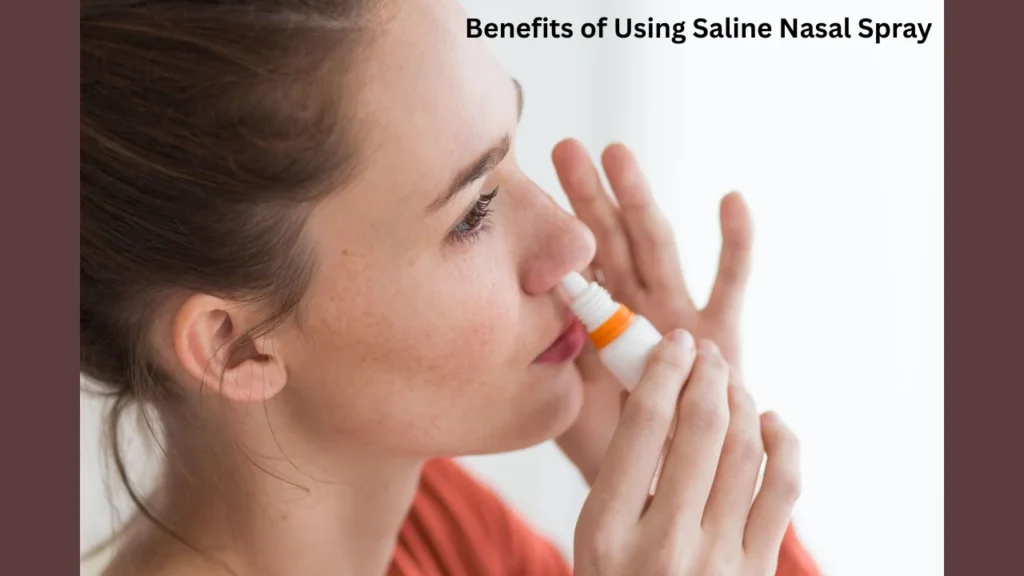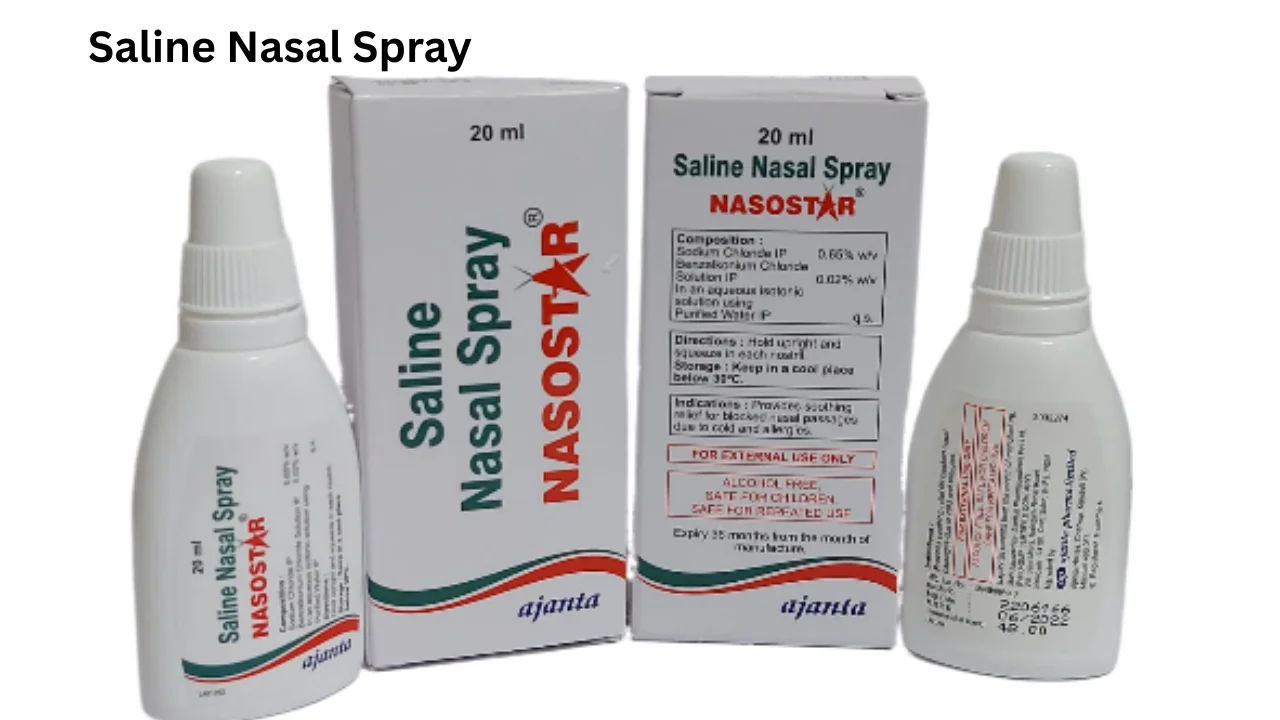Breathing clearly is something we often take for granted until a stuffy nose gets in the way. Whether it’s due to allergies, a cold, or dry air, nasal congestion can make everyday life uncomfortable. That’s where saline nasal spray comes in. This gentle, drug-free solution helps keep your nasal passages clean, moist, and free from irritants. Safe for both kids and adults, it’s a natural way to support healthy breathing and relieve nasal discomfort without side effects.
What Is Saline Nasal Spray?
Saline nasal spray is a gentle, non-medicated solution made of salt (sodium chloride) and sterile water. It is designed to moisturize the nasal passages, thin mucus, and help clear out dust, pollen, and other particles from the nose. Since it does not contain active drugs, it’s safe for people of all ages, including infants and the elderly.
This simple remedy has become a must-have in homes, especially during allergy seasons, colds, or dry weather. It provides relief without side effects or the risk of dependency.
ALSO READ: GVF90433S Gama Hot Water Heater Specs Features And Pricing
How Does Saline Nasal Spray Work?
When you spray it into your nostrils, the saline solution does a few things:
- It moisturizes dry nasal tissue caused by air conditioning, heaters, or dry climates.
- It loosens thick mucus, making it easier to blow out or drain.
- It flushes out allergens, dust, and pollutants that may be stuck in your nasal passages.
- It can help reduce inflammation and congestion, especially when used regularly.
Unlike medicated sprays, a saline nasal spray doesn’t shrink blood vessels. Instead, it supports your nose’s natural cleaning process.
Types of Saline Nasal Spray
There are a few different types of saline sprays available over-the-counter:
| Type | Description | Use Case |
|---|---|---|
| Isotonic | Same salt level as body fluids (0.9% sodium chloride) | Everyday use, safe for infants |
| Hypertonic | Higher salt concentration than body fluids | Stronger relief for nasal swelling |
| Buffered | Has ingredients to balance pH for better comfort | Less irritation for sensitive users |
| Non-buffered | Simpler formula with just salt and water | Basic option, may sting slightly |
Each serves a slightly different purpose, but all help improve nasal hygiene.
Benefits of Using Saline Nasal Spray

Using saline nasal spray comes with many health benefits. Here are some of the top ones:
Natural Relief from Congestion
Whether you have a cold, flu, or seasonal allergies, saline spray helps clear up nasal congestion without needing medication.
Gentle for All Ages
From babies with stuffy noses to seniors with dry sinuses, saline spray is safe and effective for everyone.
No Risk of Overuse
Unlike decongestant sprays, saline solutions don’t cause rebound congestion or dependency when used long-term.
Supports Allergy Management
Regular use flushes out allergens like pollen, dust mites, and pet dander, reducing symptoms and flare-ups.
Post-Surgery or Sinus Care
Doctors often recommend saline nasal spray after nasal surgeries or for chronic sinusitis to keep passages clean and promote healing.
ALSO READ: EVD Device LTAC Facility Innovations In Neurological Care
How to Use Saline Nasal Spray Properly
Using it the right way ensures better results. Here’s a step-by-step guide:
Blow your nose gently to clear mucus.
Shake the bottle and remove the cap.
Tilt your head slightly forward and to one side.
Insert the nozzle into one nostril.
Spray once or twice while breathing in gently.
Let the solution drain or blow your nose lightly.
Repeat on the other nostril.
Clean the nozzle and replace the cap.
Use it 2 to 3 times a day, or as recommended by a doctor. Overuse won’t cause harm but may be unnecessary.
Saline Nasal Spray for Babies and Children
Babies and toddlers can’t blow their noses well, making nasal congestion more uncomfortable for them. That’s why saline nasal spray is a pediatrician-approved choice.
For infants:
- Use drops instead of a spray.
- Lay the baby on their back.
- Drop 1-2 drops into each nostril.
- Use a bulb syringe to gently remove loosened mucus.
This helps improve sleep and feeding, especially during cold or allergy seasons.
Homemade vs. Store-Bought Saline Nasal Spray
You can make saline nasal spray at home using:
- 1 cup of distilled or boiled and cooled water
- ½ teaspoon of non-iodized salt
- Optional: A pinch of baking soda to reduce stinging
Mix thoroughly and store in a clean container. Always use fresh solution and keep it sterile.
However, store-bought options are convenient, pre-sterilized, and come with easy-to-use nozzles. For frequent use, many people prefer the ease of commercial sprays.
When to Use Saline Nasal Spray
You can use it for many common situations:
| Use Case | Benefit |
|---|---|
| Cold or flu | Loosens mucus, relieves congestion |
| Seasonal allergies | Flushes out allergens, reduces sneezing |
| Dry climates or winter | Moisturizes nose and prevents nosebleeds |
| Post-surgery care | Keeps nasal passages clean and reduces crusting |
| Daily hygiene | Maintains nasal health in polluted or dusty environments |
Some people include it in their daily health routine, just like brushing their teeth.
Possible Side Effects
Though rare, a few users may experience:
- Slight stinging or burning
- Temporary nasal dryness
- Sneezing after use
These side effects usually happen with non-buffered sprays or improper technique. Using a buffered solution and avoiding overuse helps minimize discomfort.
If symptoms worsen or you notice unusual side effects, consult a healthcare provider.
Choosing the Right Saline Nasal Spray
Not all sprays are the same. Here’s what to look for when shopping:
- Is it isotonic or hypertonic? For daily use, go with isotonic.
- Buffered formula: Helps reduce stinging.
- Preservative-free: Ideal for sensitive users.
- Easy-to-use bottle: A fine mist nozzle is more comfortable than a stream.
Brands like Simply Saline, NeilMed, or Ayr are well-known and widely trusted.
Can You Use Saline Nasal Spray Every Day?
Yes! It’s safe to use daily. Unlike medicated sprays that can cause rebound congestion, saline nasal spray supports your body’s natural processes. For people living in dry climates or those exposed to allergens daily, routine use can offer great relief.
Doctors often recommend daily use to those with:
- Chronic sinus issues
- Allergies
- Frequent colds
- Occupational exposure to dust or chemicals
Pricing of Saline Nasal Spray
One of the biggest advantages of using it is its affordability. Whether you choose a basic store-brand bottle or a well-known medical-grade product, most options are budget-friendly. Prices vary based on the brand, type (isotonic vs. hypertonic), bottle size, and whether it comes in a spray or dropper form.
Below is a table showing common saline sprays and their average pricing:
| Brand Name | Type | Bottle Size | Approx. Price (USD) | Best For |
|---|---|---|---|---|
| Simply Saline | Isotonic | 4.5 oz | $4 – $6 | Everyday use for adults and children |
| NeilMed Sinus Mist | Isotonic | 4.2 oz | $5 – $7 | Allergy relief and daily use |
| Ayr Saline Nasal Mist | Buffered Isotonic | 1.69 oz | $3 – $5 | Sensitive noses, infants |
| Ocean Nasal Spray | Isotonic | 1.5 oz | $4 – $6 | General use, compact size |
| Xlear Nasal Spray | Hypertonic w/ Xylitol | 1.5 oz | $6 – $8 | Extra congestion relief |
| CVS Health (Store Brand) | Isotonic | 3 oz | $2 – $4 | Budget-friendly option |
Saline Nasal Spray vs. Decongestant Sprays
| Feature | Saline Nasal Spray | Decongestant Spray |
|---|---|---|
| Drug-Free | ✔ | ✘ (contains medication) |
| Safe for Daily Use | ✔ | ✘ (can cause rebound) |
| Suitable for Infants | ✔ | ✘ |
| Long-Term Relief | ✔ | ✘ (short-term only) |
| Side Effects | Minimal | Possible dependency |
Use it for maintenance, and save decongestants for short-term relief only when needed.
Frequently Asked Questions
Can I use saline nasal spray every day?
Yes, it is safe to use daily. It does not contain any medicine, so there’s no risk of overuse or side effects. Daily use helps keep your nose clean and moisturized, especially if you live in a dry or dusty area.
Is saline nasal spray safe for babies and children?
Yes, it is safe for all ages, including babies. For infants, it’s better to use saline drops and gently suction the nose afterward. Always check the label to make sure the product is designed for children.
What’s the difference between saline spray and decongestant spray?
It contains only salt and water, while decongestant sprays have medicine that shrinks swollen blood vessels. Saline is safe for long-term use, but decongestants should only be used for a few days to avoid rebound congestion.
Final Thoughts
Saline nasal spray is a simple yet powerful tool for better respiratory health. Whether you’re fighting a cold, managing allergies, or just keeping your nose clean, it’s a go-to solution that’s safe, affordable, and easy to use.
Its versatility makes it suitable for every household. From infants to adults, athletes to office workers—anyone can benefit from the consistent use of a saline spray.

